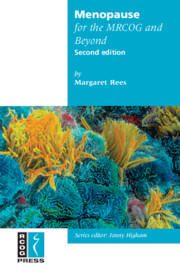Book contents
- Frontmatter
- Contents
- Preface
- Abbreviations
- 1 Definitions and controversies
- 2 Explaining risk
- 3 Systemic hormone replacement therapy
- 4 Non-HRT options for osteoporosis
- 5 Diet and lifestyle
- 6 Alternative and complementary therapies
- 7 Vasomotor symptoms, urogenital and sexual problems
- 8 Osteoporosis and autoimmune arthritis
- 9 Breast disease
- 10 Benign and malignant gynaecological disease
- 11 Premature menopause
- 12 Women with concomitant medical conditions
- Index
6 - Alternative and complementary therapies
Published online by Cambridge University Press: 05 July 2014
- Frontmatter
- Contents
- Preface
- Abbreviations
- 1 Definitions and controversies
- 2 Explaining risk
- 3 Systemic hormone replacement therapy
- 4 Non-HRT options for osteoporosis
- 5 Diet and lifestyle
- 6 Alternative and complementary therapies
- 7 Vasomotor symptoms, urogenital and sexual problems
- 8 Osteoporosis and autoimmune arthritis
- 9 Breast disease
- 10 Benign and malignant gynaecological disease
- 11 Premature menopause
- 12 Women with concomitant medical conditions
- Index
Summary
Concerns about the safety of estrogen-based HRT after publication of the Women's Health Initiative study and Million Women Study have led to women turning to alternative and complementary therapies erroneously believing that they are safer and ‘more natural’. In the USA, one in three adults uses such strategies and, worryingly, may not consult their health professional. There are major concerns about interactions with other treatments, with potentially fatal consequences. Concern also exists about the quality control of production and contaminants such as arsenic, lead or mercury. While a European Union Directive on traditional herbal medicinal products was implemented in October 2005 in the UK, this will not cover products bought by women outside Europe. Evidence from randomised trials that alternative and complementary and therapies improve menopausal symptoms or have the same benefits as conventional pharmacopoeia is poor.
Herbal products
A wide variety of herbs are used and a summary regarding their efficacy and safety is given below.
ACTAEA RACEMOSA (BLACK COHOSH)
The root and rhizome of black cohosh, an indigenous North American herb, have been extensively researched for the relief of menopause-related symptoms. German health authorities endorse the use of black cohosh extract for premenstrual discomfort, dysmenorrhea and menopause. Similarly, the World Health Organization recognises its use for ‘treatment of climacteric symptoms such as hot flushes, profuse sweating, sleeping disorders and nervous irritability’. Most studies indicate that black cohosh extract reduces some symptoms associated with menopause; however, methodologic shortcomings and variations in product and dosage limit definitive conclusions.
- Type
- Chapter
- Information
- Menopause for the MRCOG and Beyond , pp. 43 - 50Publisher: Cambridge University PressPrint publication year: 2008

